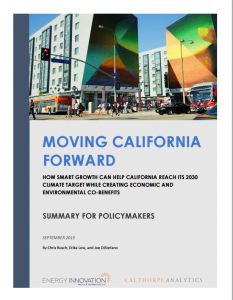Full Title: Moving California Forward: How SmartGrowth Can Help California Reach Its 2030 Climate Target While Creating Economic and Environmental Co-Benefits
Author(s): Chris Busch, Erika Lew, and Joe DiStefano
Publisher(s): Calthorpe Analytics and Energy Innovation Policy and Technology LLC
Publication Date: September 1, 2015
Full Text: Download Resource
Description (excerpt):
This past spring, Governor Jerry Brown set a goal of reducing California’s carbon emissions in 2030 by at least 40% below the 1990 level of emissions (Executive Order B-30-15). This target, now reflected in the proposed legislation of Senate Bill 32, is both scientifically grounded and feasible. But achieving the target will require California to intensify its policy efforts across all sectors of the economy. This study analyzes the role of land use policy in achieving the emissions target. Our results show that implementation of smart land use policy, in combination with technological advances in the energy sector, will be critical for the state to achieve its ambitious 2030 decarbonization target.
We recommend that the California Air Resources Board (CARB) strengthen emissions reduction targets under SB 375 (California’s regional land use planning law) as part of a 2030 Scoping Plan and complement these targets with substantial funding to support cities and regions so they can successfully implement the target-compliant land use plans they are tasked to develop. Along with reducing emissions, smart growth also delivers an impressive array of co-benefits: cleaner air, improved public health outcomes, lower water use, cost savings for households, reduced dependency on oil, more efficient provision of public infrastructure, reduced congestion, and the preservation of natural and working lands, which provide carbon sequestration and other ecosystem services. Smart growth will help expand the supply of housing most in demand. Increasingly, people want to live closer to work, in walkable neighborhoods that are well served by transit.
A detailed comparison of land use patterns and transportation investments play a fundamental role in how far we travel and how we get from home to work, school, shopping, recreation, and other activities. The spatial layout of neighborhoods determines whether we have the option of walking, biking, and taking public transit, or whether we must drive. Offering choices provides relief from land use patterns that otherwise promote dependence on cars for most travel. These options increase travel efficiency, reduce congestion, and improve overall mobility. This is the fundamental cause-effect dynamic at work in the results that follow. This dynamic is being put into practice in cities and regions across California. Statewide, the number of trips people take by transit, walking, and biking doubled between 2000 and 2012.
In Southern California, cities and the regional planning and transit agencies have collaborated and taken bold steps to rapidly build up a comprehensive transit system. These efforts are steering more housing and job growth to new and existing transit-connected locations. The Bay Area recently saw the nation’s biggest reduction in the share of people commuting alone by car. These changes are cutting emissions by reducing reliance on cars for everyday travel needs. This is a crucial step toward reducing emissions from passenger vehicles, the top source of carbon emissions in California (as shown in Figure ES-1).
